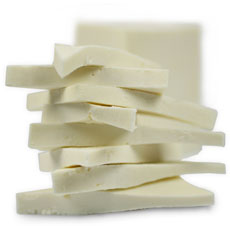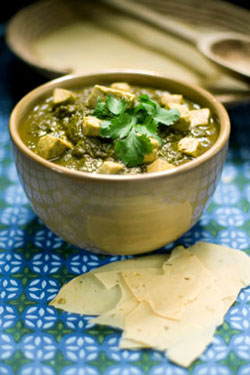
 You can buy paneer cheese at many markets, or make it yourself with the recipe on the next page. Photo courtesy iGourmet. You can buy paneer cheese at many markets, or make it yourself with the recipe on the next page. Photo courtesy iGourmet.
|
KAREN HOCHMAN is editorial director of THE NIBBLE.
|
|
March 2009
Last Updated February 2012
|
 |
Paneer
The Fresh Cheese Of India
CAPSULE REPORT: Even if “Slumdog Millionaire” hadn’t swept the Oscars, with the growing popularity of Indian cuisine, it’s time to learn about paneer (also spelled panir), the fresh cheese of India. Paneer is one of the few types of cheese indigenous to the Indian subcontinent. It’s found cut into cubes in many popular cooked dishes. It is widely used not only in Indian cuisine, but in some Southeast Asian and Middle Eastern cuisines as well. And, it doesn’t melt when it’s grilled!
Overview
Paneer is a traditional, full-fat, fresh curd (unaged) cheese used in Indian cooking. It is also called cottage cheese or farmer cheese, and can be substituted for these cheeses and ricotta in most recipes. While in its curd form, paneer looks like ricotta; when pressed until firm, it resembles tofu. It is actually similar to the Latin American queso blanco, although unlike queso blanco, it is made without salt.
All cheese starts off by the addition of a coagulant (curdling agent) to milk that has been brought to a boiling point. With many cheeses, an enzyme, rennet, is used to coagulate the milk proteins. Since rennet is made from the lining of a calf’s stomach and is not eaten by vegetarians, an acid reagent is used that makes paneer acceptable to India’s large vegetarian population (and paneer is an example of what is known as a “vegetarian cheese”).
An excellent source of protein, paneer makes a fine meat substitute. It is essential to 80% of India's diet and can be found in many recipes, including meat-based ones. It is an integral part of South Asian cooking, used in main courses, desserts and snacks.
How Paneer Is Made
In most cheesemaking, the whey proteins (albuminous proteins) don’t coagulate. Instead, they are drained off, and can be used to make ricotta, fed to livestock or put to other use (e.g. to make the whey protein sold in health food stores).
Paneer is different. An acid reagent (vinegar, lemon juice, yogurt, citric acid or cultured buttermilk), rather than rennet, is added to hot milk. When the milk curdles, both the milk proteins and the whey proteins coagulate.
While this cheese resembles ricotta in appearance, most varieties are then usually pressed until firm like tofu, then eaten in cubes or slices.
There are regional variations: The eastern Indian variety is beaten or kneaded like mozzarella, and crumbles more easily than the North Indian style of paneer. Like tofu, there are softer and harder versions of paneer, used in different recipes.
If you can’t find paneer locally, you can buy it online at iGourmet.com or make it yourself with the recipe on the next page.
|
|

Palak paneer, spinach with cubes of paneer in a creamy curry sauce. Photo by Christine Glade | IST.
|
Continue To Page 2: Paneer Recipe
Lifestyle Direct, Inc. All rights reserved. Images are the copyright of their respective owners.

|





